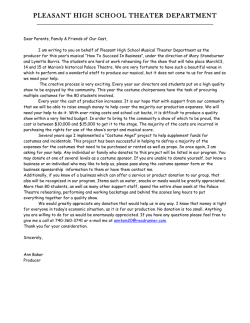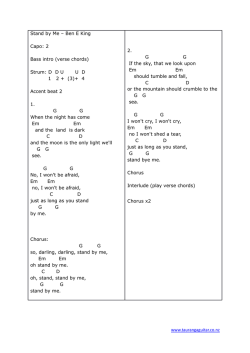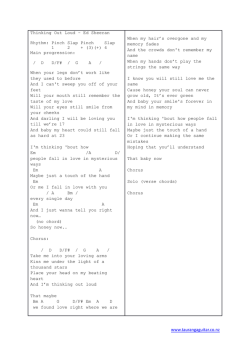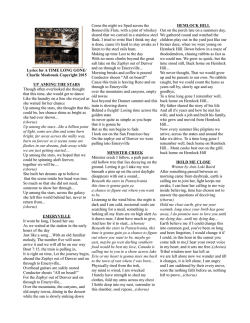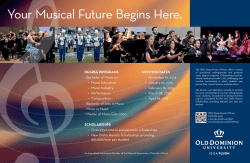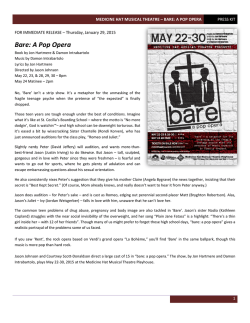
Spring 2015 Town Crier.
Town Crier Painting by Kitty Wallis CABRILLO CHORUS - SPRING 2015 2015 Symphony Concert: Sacred and Profane • O Magnum Mysterium - Tomás Luis de Victoria • Carmina Burana - Carl Orff Classic Evening On May 9th and 10th Cheryl will lead us in a partnership with the Santa Cruz Symphony under the musical direction of Daniel Stewart, with soloists from the Metropolitan Opera and the children from the Cabrillo Youth Chorus for a dramatic conclusion to the symphony’s 57th season featuring Carl Orff’s awe-inspiring choral masterpiece, Carmina Burana. Encore Matinee This energetic work by the German composer and folklorist will be performed costumed in medieval garb. The chorus has some great resources for this event having performed in costume in 1993 during our Eastern European tour and again with the Symphony in 2003. “The goddess Fortuna must have been smiling on me when, as if by chance, she put a copy of a catalogue in my hands. It was published by a seller of old books in Wurzburg, and one title in the list attracted me with an almost magical force: Carmina Burana,” wrote Carl Orff in his memoirs about the discovery of the manuscript in Benediktbeuem Monastery which would serve as the basis for his best-known work. • 8PM Saturday, May 9th 2015 • Santa Cruz Civic Auditorium • 2PM Sunday, May 10th 2015 • Mello Center, Watsonville Please reserve the evenings of May 5th-8th for rehearsals at the civic. Details to follow. From the S.C. Symphony Program Notes by Don Adkins Carmina Burana comes from a collection of songs found in the library of a monastery in the foothills of the Bavarian Alps. The original source, a 13thCentury Latin codex, was brought to light when the Abbey of Benediktbeuern was secularized by the Austrian Emperor in 1803, a move undertaken in the spirit of enlightenment to redistribute wealth from the church back to the people. The codex was published in 1847 under the title later chosen by Orff for his work. The song texts are a collection consisting mainly of works by travelling musicians. These lively poems, about 200 of them, come from France, Germany, England and Italy and deal with all areas of human existence – sacred, secular, social and personal. The topics include the sensual pleasures of food, drink, romantic and physical love; satires on church, state and social interaction; and complaints about money and declining moral values. Although we do not know most of the authors, the intellectual elite of the 13th Century, both settled and nomadic, appear to be responsible for most of the Latin poetry and song texts. Troubadours who were trained and respected poets and musicians, and also often nobility, performed this style of music. Some of the texts mixed German and Latin or French and Latin. A few of the poems in this collection can be ascribed to some of the greatest thinkers of the time, such as Archipoeta who wrote, among other things, numerous love and drinking songs. Orff chose 24 of these texts for his work. The spiritual unity and exuberant life found in this material reflects the excitement of the 13th Century and strongly attracted him: “In all my work, my final concern is not with musical but spiritual exposition.” The poetry also sketches a picture of humanity that is still recognizable today. The illustration used as the frontispiece of the collection, a reproduction from the original manuscript, caught Orff’s imagination. A wheel of fortune is depicted, a symbol of constantly changing human experience. He decided to begin and end with the chorus “O Fortuna” and divided the rest of the texts into three sections depicting man’s encounter with different aspects of physical existence: 1. “Spring” and “On the Village Green,” 2. “In the Tavern,” and 3. “Court of Love.” Orff was once questioned about his choice of texts: “Sometimes I am asked why in the main I choose old material for my stage works. I do not feel it to be old, but only valid. The dated elements are lost and the spiritual strength remains.” Spirituality was essential to Orff’s artistic concepts, not as a way of expressing ancient ideas, but as a vehicle for depicting the mood and essence of his own contemporary experience. The subtitle of the work, “Secular songs for soloists and chorus, accompanied by instruments and magic tableaux,” demonstrates Orff’s conception of this piece as a theatrical production. The first performances were staged in a wide variety of styles, ranging from a cosmological music-drama to an allegorical medieval mystery play. Orff’s entire Set design by Helmut Jürgens for a performance in Munich in 1959: 2 musical output can be categorized as school or stage works: he considered all of his work to be theatrical. One acquaintance wrote: “Orff’s first reaction to the collection of Carmina Burana was as a man of the theatre, who saw it as a colorful dance and song drama. The function of Orff the musician was to work out a setting for this dramatic inspiration. The mimed events are the primary source of the music, which is, consequently, rhythmic and incredibly concentrated.” If we depended on large theatrical performances for the only live presentations of this music, the opportunity to enjoy Orff’s creation would be extremely limited. Even though staging can make the symbolism easier to understand, most performances today are concert versions sometimes with minimal production elements. Orff’s mature style is evident in all aspects of Carmina Burana. The song forms are usually strophic, a repetition of the same music for the different verses. The orchestra creates static blocks of sound through the use of simple ostinatos, repeated accompaniment patterns, and unchanging tonal colors. This simplification is often given the label primitivism, a term that was strongly associated with the earlier music of Stravinsky and often pertained to the prominence of rhythmic drive. Orff used this approach to express what was important to him. Otto Oster wrote: “Rhythm is not merely the medium of Carl Orff’s art; it is the spiritual foundation of his musical architecture.” Orff felt that all of his theater works were dependent upon artistic primitivism: “The nearer one comes to the essence of the statement, the near to absolute simplicity, the more immediate and powerful is the effect.” Gregorian plainchant, Italian opera and Lutheran chorales. The unifying factor that draws everything together is his simple approach to rhythm, pitch and orchestral color. His use of the voice is an essential element of his overall sound and one of his most important contributions to musical practice. Orff is highly sensitive to the tonal sub-structure of language: the musical qualities found in the spoken word. He uses the naturally occurring rise and fall of the text as the basic contour of his melodies. Even though many composers have done the same, Orff’s approach is so sensitive and effective that it is an indispensable element of his style. From the first performance, Carmina Burana has enjoyed tremendous success. It was first seen as a controversial but successful example of the new world-theater striving to present stage works outside of the standard European approach. As a large-scale choral work it has become one of the most performed internationally due, in large part, to its simple presentation of the universal concepts of fortune, nature, beauty, wine and love. The musical styles include Bavarian folk songs, 3 Carl Orff 20th Century German Composer Orff Schulwerk Percussion Instruments The following is taken from the Guide to Choral Masterpieces by Melvin Burger: Born July 10, 1895, in Munich Died March 29, 1982 in Munich Carl Orff’s early years gave no hint of the direction his life and music were to take. Born to a wealthy, cultured family, Orff displayed his musical abilities at an early age, had his first compositions published at age fifteen, and graduated from the Munic h Academy of Music when he was nineteen years old. For several years, while continuing to compose in what can be termed a post-Romantic style, he held various conducting and coaching positions at opera houses in Munich, Mannheim, and Darmstadt. Then came the turning. In 1920, Orff began studying with Heinrich Kaminski, a reclusive, mystic composer. Collaboration with dancer Mary Wigman at about the same time led to an interest in the eurhythmics of Emile Jaques-Dalcroze, who focused his attention on the physical elements involved in the creation and perception of music. ”I’m a native Bavarian, born in Munich, and this city, this country, this landscape have given me so much, have shaped my self and my oeuvre.” -Carl Orff Carl Orff’s childhood in Munich, where he was born on July 10, 1895, was full of impressions which would influence his later works. . . Then, in 1925, with Dorothee Günther, Orff founded the Güntherschule, a music school that put into practice his evolving ideas on music education— that music should generate physical movement, that physical movement should generate music, and that improvising on simple percussion instruments, starting with the rhythmic patterns of everyday speech, should be a central part of every child’s education. Out of his experience at the Güntherschule came Orff’s five-volume teaching course, Schulwerke—an important publication, still in active music’ education use, that links music, speech, and gesture. The first work by Orff that showed the influence of his rethinking of the fundamental concepts of music was Carmina Burana, a scenic cantata he composed in 1935 and 1936. On its completion he disowned all of his previous music, making Carmina Burana, in effect, his first composition. Over the following years Orff wrote exclusively for the stage, since he believed that the potential of concert music had been largely exhausted. Catulli carmina (1943) and Trionfo di Afrodite (1952) are dramatic cantatas that Orff later added to Carmina Burana to form a trilogy, which he entitled Trionfi. Neither the two later works nor his more operatic stage creations have had nearly the impact or the popularity of Carmina Burana. 4 Hear Ye, Hear Ye! It’s time to start thinking about your simple medieval peasant costume! You are responsible for gathering and creating your own garb. We are enclosing some pictures to give you ideas and guidelines. We will arrange times during rehearsal for those who have costumes prepared to come in their peasant ware, so you can see what they’ve come up with. We hope you will be able to find most items in your own or in a friend’s closet, or at thrift stores. Other pieces can be easily sewn. We may be able to share some limited fabrics and ready-made costume pieces with each other. Look for extra costume items you could lend to others. We will announce how and when to do this at rehearsal. The Look The look is medieval peasant, NOT Camelot, Renaissance Faire, King Arthur’s Court or Robin Hood. Defining the Wearer (from The Medieval Tailor’s Assistant by Sarah Thursfield) “Two main factors need to be taken into account in deciding what dress is appropriate. Wealth and status - Dress was an important indicator of income and status. The dress of the wealthy demonstrated that they were not subject to the hardships of normal work, and had the leisure and servants required to dress them. A picture from the 2003 Performance of Carmina Burana: Visual sources show that male manual workers wore their clothes around knee length for convenience and might strip off their outer clothes in hot weather, while professionals such as lawyers and doctors wore sober calf-length garments of finer quality, and full-length robes were worn by senior clergy, noblemen and royalty. Women’s clothes were long, but working women might tuck up their skirts above their ankles, while grander ladies wore them trailing over their feet. A rural worker would usually be limited to the cloth available in his local market and the skills of the person making (or remaking) his garment. Towndwellers had a wider choice but their clothes would still be made to last, so they tended to be plain and substantial. Age - Young men wore short outer garments, but older men wore them calf-length or longer. Unmarried women could wear their hair loose and their necklines low; married women were expected to cover their hair and be more modest, while widows often dressed plainly and in earlier styles.” 5 The Cast Your “character” may be any lower-class version of those mentioned drinking in Taberna: • • • • • • • The mistress, master or soldier A manservant or serving maid The quick, the sluggard or the steady A wanderer, simpleton or wise person A poor, sick or exiled person A youth, old man, old crone or mother Various people of God: a sister or brother, nun or friar The Color Scheme The color scheme is beige, brown, rust and off-white with accent colors of muted blues and greens. Avoid red, orange, yellow and purple. Also please avoid (or hide) zippers and buttons (especially in front.) Avoid any shiny fabrics, prints, patterns, jewelry and watches. Men’s Costumes Shirts: All sleeves should be full or 3/4 length. They can be rolled. Avoid modern, dress-style collars and cuffs. Go for blousy look; “poet” or “artist” type shirts, smocked, or gathered; peasant shirts, but without colored embroidery. Long sleeve tee-shirts with collar and cuffs cut off will work in a neutral color. Legwear: Leggings and Tights are preferable! (Borrow them from your women friends.) Remember, non-shiny earth tones; black is okay. Or loose fitting pants; khaki, beige, brown, rust or black. Shorts can be worn if adapted as shown in the illustrations handed out in class. NO JEANS! Codpieces: Highly desirable! We know you’ve always wanted to wear one! Tunics: Can be of various lengths can be easily sewn, or even not sewn but left open at the sides. They can have long sleeves or be worn over a shirt. Head Gear: Cowls, hoods, caps and capes, as shown in the illustrations. Bare head is okay. 6 Women’s Costumes Skirts and Dresses: should be mid-calf or longer. Sleeves should be long or 3/4. Aprons, Tunics and Overvests desirable. Peasant Blouses: avoid short sleeves or colored embroidery. Head Gear: Wimples, cowls, scarves, flower circlets and ribbons are all wonderful. Bare heads are okay, too. 7 Footwear For men and women, sandals, ballet shoes, tai-chi shoes, clogs, moccasins, Ugg boots, T-straps, flatsoled boots, pointy-toed cloth shoes will all work in brown or black. Women, if your skirts are long there is less to fuss about footwear! Belts and Bags Belts: rope, fabric sashes, rustic looking leather. Bags: various rustic “hand sewn” or leatherwork bags may be worn over the shoulder, around the neck or suspended from belts. 8 Inspiration: The Carmina Burana YouTube Movie has a blend of styles but it is a great way to get the “idea” of the piece (although it is slightly racy) and it provides costume inspiration. Performed by the Mitteldeutschen Rundfunks chorus, orchestra and ballet, conductor: Daniel Nazareth. Try clicking on the links below or copy and paste the URL into your browser: Part One: Fortuna Imperatrix Mundi https://www.youtube.com/watch%3Fv%3DR0bwVxTSntk Part Two: Primo vere https://www.youtube.com/watch%3Fv%3D-QfNpBAIZoA Part Three: Uf dem anger https://www.youtube.com/watch%3Fv%3DWkLD2cFSTyk Part Four: in taberna https://www.youtube.com/watch%3Fv%3DwF6RaarfmfI Part Five: Cour D’amoures https://www.youtube.com/watch%3Fv%3D1-nhJKjj_S0 You can also keep in touch and find these and more links on the Chorus Website: http://www.cabrillo.edu/academics/music/symphonicchorus/carmina_Burana.html Summer (Aestas) from the series The Seasons by Pieter van der Heyden 9
© Copyright 2026
